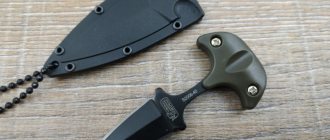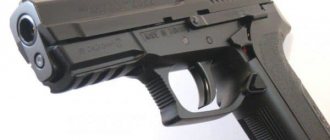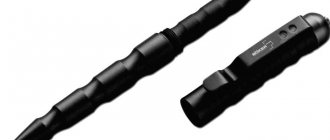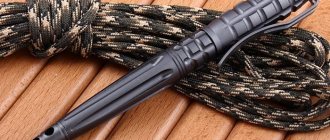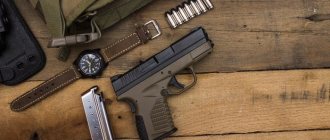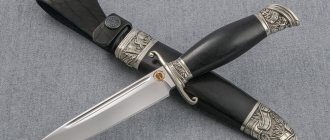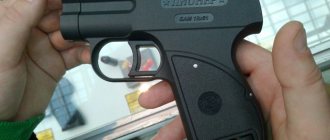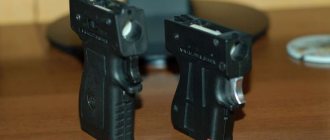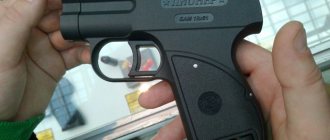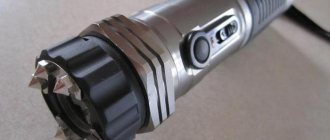The most affordable and popular weapon for self-defense is a knife. Knives, as bladed weapons, have been used for centuries; hundreds and thousands of different versions of this bladed weapon have been created. One of them is the hero of this article – a butcher knife.
The blade is small in size, so it is quite compact, and manufacturers of modern accessories often build it into utilitarian items - purses, belt buckles, wallets, and so on. At the same time, a butcher knife in skillful hands can cause terrible wounds.
History of creation
Today we cannot say exactly who and when first came up with the idea that the blade does not necessarily have to continue the handle of the knife or sword. However, this happened quite a long time ago. This type of bladed weapon design is first encountered in the East, or more precisely in India. It was there that the Katara daggers, well known to historians, as well as the Pata swords appeared. The concept of this weapon was similar: its blade was located perpendicular to the handle, which was clamped in the fist. Additional fixation of the weapon was provided by branches of the guard or simply leather belts, with which, for example, the catarrh was simply tied to the forearm.
As mentioned above, modern push dagger actually originated in the United States. There is no doubt about this, but it is not entirely clear how this happened.
There is a hypothesis that its prototype was the traditional Eskimo knife ulu, which they used for skinning and other household needs.
According to another version, the idea of creating a push-dagger came to the United States from the East along with emigrants. “Asian” motifs are too clearly visible in the stab knife.
Push-daggers came into use during the development of the Wild West and the famous American Gold Rush. At this time, the United States was flooded with adventurers, rogues, and even simply seekers of a better life from various countries of the world. Of course, among them there were also emigrants from the East who might have been familiar with the ideas of Indian gunsmiths.
They say that initially the stab knife became popular not among tough cowboys or gold miners, but among parlor card sharpers and petty urban criminals. Very similar to the truth. For a cowboy or prospector, a Bowie knife is much more suitable, with which you can cut a steak and kill your opponent in a fight. A push-dagger is a weapon exclusively for fighting; it is almost impossible to use it for economic purposes. In addition, a butcher knife is a very small thing that can be carried with you unnoticed and used as a last resort.
One of the first butting knives to appear in the CIS was the Taganka push-dagger, which was released by . This weapon has become so popular that now “Tagankas” are often called any butcher knives.
Cold steel: definition according to Russian law
The definition of what a cold weapon is, according to the law of the Russian Federation, is as follows:
“Melee weapons are weapons designed to hit a target using human muscle power in direct contact with the target;”
It is in Article 1 of legal document No. 150-FZ dated December 13, 1996, which is still valid in 2022. More information about what types of knives fall into the category of edged weapons is available in GOST R 51500-99 and R 51548-2000.
GOST for manufacturing
GOST R 51500-99 prescribes what a hunting edged weapon should be. More precisely, in accordance with the document, the belonging of knives to this category is established by expert means. We are talking about the length of the blade, the sharpness of the blade, the ergonomics of the handle, that is, all the previously mentioned characteristics.
GOST R 51548-2000 regulates the design features of survival knives and applies not only to them, but also to homemade tools. It also indicates which of these types are not edged weapons (blade up to 9 cm inclusive, butt thickness up to 2.6 mm, steel hardness up to 42 units, etc.).
When determining whether a knife belongs to the category of edged weapons, the requirements of the standards and Federal Law No. 150 of 1996 are compared.
Watch the video about the signs of edged weapons:
Description of the butcher knife
A butcher knife is a small knife shaped like the letter T or L. The main difference from other knives is that the handle is perpendicular to the blade. The knife usually has a fixed blade; folding versions of this knife are less common.
The blade of a knife is mainly made of steel; most often, to increase rigidity, the blade and the handle of the knife have a common base.
And for ease of holding, polymer or wood cheeks are placed on the handle. Rope or leather braiding is less common.
The first mass use of this type of knife was recorded during the “gold rush” in the USA, in Alaska.
But nevertheless, similar varieties of the blade are found both in Africa and in the East, for example, the Indian Qatar, a type of national thrust knife; one can recall the push-dagger knives loved by British sharpers in drunken fights in England during the era of the Great Discovery.
The main advantage of a butcher knife as a weapon is its secrecy; it is practically invisible on clothing. Hidden in the folds of clothing or in a belt buckle, this knife will be a clear surprise to an unarmed and unprepared enemy.
Nowadays, all butcher knives are positioned as knives for self-defense. The use of knives for this purpose is generally questionable, since knife wounds are very dangerous and can be fatal. If you want to protect your life and health with a knife, be prepared to face exceeding self-defense measures and the possibility of ending up in prison.
However, if you choose from a bunch of different models of knives, it is the butcher ones that cause the least dangerous wounds due to their short blade. However, even from shallow wounds the enemy can die due to blood loss.
Steel arms. Signs and classification in accordance with the legislation of the Russian Federation
Based on our legislation, edged weapons are divided into various types depending on the type of use, purpose, purposes for which they are purchased, as well as based on their own characteristics and features. Among these types there are three main ones:
- Combat. It can be hand and rifle. It is used to solve official operational or combat missions only if the case allows its use in accordance with the law of the Russian Federation on the use of edged weapons. Most often found in public and private military organizations.
- Official. It is carried by representatives of law enforcement agencies, government officials, as well as legal entities that have permission to do so.
- Civil. In fact, every citizen of the Russian Federation can obtain the right to carry this type of bladed weapon. It is used for hunting, related sports, self-defense, etc.
Steel for production
Since the task of a push dagger is not to cut food or plane wood, the steel used to make it generally does not have outstanding characteristics. The blade of a butcher knife must have the following qualities:
- Stainless steel;
- The thickness of the blade should prevent its accidental breakage;
- The sharpening angle of the blade should be 65 degrees.
All these parameters are advisory in nature, based on the characteristics of the use of this type of knives. If desired, you can change them to suit your needs.
Steel grades for push dagger:
- Stainless steel 40x13. Used mainly on kitchen knives, often used for butcher knives;
- Stainless steel 65x13. This is a higher quality steel, used for expensive models of kitchen knives and simple hunting knives. This steel and its foreign analogues are used for more expensive models of butting knives.
It happens that more expensive grades of steel are used for butcher knives. These are mainly piece models made to order.
DIY making
If you cannot choose a push-dagger that suits your hand or want to get a high-quality knife in a single copy, you can make it yourself. For manufacturing, you will definitely need a drawing, a steel blank, material for the handle and a set of tools. The drawing is needed to understand what shape your future knife will be.
Stages of work:
- A drawing is drawn;
- A steel blank is cut out;
- Holes are drilled in the handle to secure the linings;
- Using a grinder, slopes are created on the blade;
- The blade is polished;
- The elements of the handle linings are turned and secured.
Many difficulties may arise during work. For example, a grinder is a rather specific tool; if you don’t have one (and most likely you won’t), you’ll have to make the cuts on an electric sharpener, which requires a lot of experience. Usually the sharpening turns out well after making 5-6 knives. When drilling holes in hardened steel, you may need a drill press. Sanding is a fairly lengthy process that involves the use of sandpaper of different grits.
If your blade is not hardened, making descents is much easier. Only then you need to harden it and temper it using a technology that few people know, so it is better to use a hardened workpiece. When working on a sharpener, the main thing is not to overheat it, otherwise the hardening will be lost. There is no need to rush; the workpiece needs to be cooled in water more often.
A butcher knife is an interesting self-defense weapon. Whether you purchase a serial copy or make it yourself, the main thing to remember is that it is better to resolve any conflict peacefully, avoiding unnecessary bloodshed.
Modern models
Due to the growing demand for butting knives, many companies have mastered their production. Let's look at a few of the most popular models:
- Taganka from. One of the first representatives of butcher knives in the CIS. Available in various versions of the handle, without pads, with wood and textolite. Without overlays it is highly not recommended for use;
- Paul Chen Citizen. Chinese manufacturer producing high-quality replicas of Japanese and other swords. This model is very different from traditional butcher knives. It is foldable and can be fixed in several positions. Depending on this, it is used as a regular folding knife or as a push-dagger. The quality of workmanship is at a very high level (price, however, too);
- Viking Nordway, model K323. This knife company produces many models of inexpensive knives. Of the entire line of butting knives, model K323 has the most interesting design and functionality. This knife is a slightly redesigned copy of the Seraphym knife from Mercworx;
- Cold Steel Safe Maker I. A very aggressive model from a manufacturer from the USA. Has a dagger blade, which improves permeability;
- Cold Steel Safe Keeper III. A more peaceful model from the same manufacturer. It can be used not only for self-defense; due to the shape of the blade, it is suitable for breaking glass in a car in an accident.
Secrets of home steel hardening
When carrying out such manipulations yourself, you will first of all have to take care of the heating source for the steel. In “home” conditions, a good solution could be:
- muffle furnace. In it, thanks to the muffle, the material does not come into contact with combustion products, the temperature is maintained constant and uniform without any external effort, as a result of which forging will be carried out with high quality and accuracy;
- blowtorch. To ensure uniform heating and holding, you will have to build something like a pipe, or make a “hut” out of bricks;
- horn Like an open forge, you can dig a small hole in the ground, line it with bricks (to maintain the temperature), build a fire and get to work. Charcoal is ideal as fuel;
- Special craftsmen can make something like a forge on a gas stove from a tin can. It is most convenient if it matches the size of the blade.
Drills, bearings, files, springs and even cable are suitable as starting materials. Such already used products may require rust removal. To do this, you can use a grinder.
When immersing a blade in an environment with a certain critical temperature, care should be taken to ensure that the handle of the knife does not come under the influence of heat.
The quality of hardening is checked by simply running a file over the product: an under-hardened sample will stick to it, and the edge of the blade will simply bend. If the product turns out to be under-hardened, you can try to repeat it - first annealing, and then hardening, and thus save the part.
There is a way to correctly determine the moment when the hardening of the product has taken place: at that moment the metal begins to tremble and emit sounds similar to a groan or whistle.
When releasing, the knife blade should be lowered only vertically, with the denser part down, and slightly rocked along the blade. This approach will minimize the possibility of deformation.
The tempering stage can be handled without any additional equipment: an ordinary oven is enough, where the part will fit for a couple of hours with a gradual decrease in temperature.
In addition to the traditional method, there are many other theories about how to harden metal for a knife quickly and efficiently. Home craftsmen are advised to first heat the part to a bright red color, and then dip it with the cutting side into sealing wax several times in different places. Repeat the procedure until the blade stops going into oil. After this, the steel will need to be lubricated with turpentine. Actually, the knife metal hardened in this way will have to be lubricated with this liquid constantly after this. The effect of such hardening is the promise of high hardness and strength of the product without the difficulties associated with the conventional tempering method (the method is only suitable for thin blades).
After finishing stabbing and releasing the blade, all that remains is to clean it, polish it, and attach it to a ready-made knife handle made of wood, leather, rubber or metal.
“How to harden knife steel” read 2820 times
How to choose a butcher knife
Most people looking to buy a push dagger usually choose the most expensive model. But price is not the main selection criterion. When buying, the first thing you need to pay attention to is the handle. Inexperienced buyers are advised to hold the weapon in their hands to evaluate the comfort of the handle.
Experts do not advise buying knives without pads, since when struck, the palm will not be protected from cutting into the end part. The weapon will also slip in your hand, which can lead to damage.
Experts recommend taking a model with a pad or a fairly thick handle. It is important that it fits well in the hand and does not cause discomfort.
Blade length
Now we move on to consider which knives can be carried without permission. First of all, these are models whose blade length is less than 90 millimeters. Yes, it is this number that the federal law “On Weapons” ties all knives to, and not at all to the width of the palm, as many believe.
If your knife is at least 89 millimeters long, it cannot automatically be considered a melee weapon, even if it fits perfectly in the hand, is suitable for cutting and piercing blows, and has a razor sharpening.
This number should be remembered forever if you want to develop a good habit of carrying a knife and not get into trouble with the law. Some will be outraged by this restriction. But truth be told, longer knives are almost always not very comfortable to use. Almost any work that may happen in everyday life outside the home is most conveniently performed with a short knife.
Do I need permission?
Often people planning to purchase a push-dagger are interested in whether they need to obtain a permit to carry such a weapon.
In general, whether a weapon belongs to a bladed weapon is determined by the length of the blade and the hardness of the steel. Considering that the butcher knife is characterized by a short blade, permits will not be needed. Despite this, it is better to buy weapons in places where you will be provided with an appropriate certificate, which indicates the main characteristics of the push-dagger and its purpose.
What is edged weapon?
This term refers to items that, as a rule, relate to sports, hunting, and military areas. They are characterized by the fact that their work does not involve flammable or explosive substances, electricity or gas. In general, an item that can cause severe injury or even death is a bladed weapon. Signs and classification will be given below. Conventionally, weapons of this type are divided into two categories - hand-held and thrown. Among the types that have existed and exist today, the following can be listed: contact, thrown, bladed, impact, polearm, chopping, cutting, piercing, shock-crushing.
Application
The knife is used like brass knuckles, the handle is clenched in a fist, and a beak-blade is released between the fingers. Featuring a double-sided edge, this knife is not intended for chopping or cutting.
His goal is short blows with the blade penetrating deep into the wound.
Given the short length of the blade, conventional strikes with this weapon are ineffective, so combined tactics must be used in battle.
Quick strikes with the aim of inflicting as many wounds as possible, the strikes themselves, with an additional twist of the blade. This will allow the blade to expand the knife channel and, on the return stroke, apply rough cuts to the edges of the wound using the edges of the blade.
After a series of blows, you need to break the distance or, on the contrary, enter into a clinch with the enemy. This will allow you to wait until the enemy loses combat effectiveness due to blood loss.
The question often arises: is a butcher knife a weapon or not?
But the answer to it is hidden in our legislation. The law regulates weapons according to the length of the blade and its hardness. A knife with a short blade, not a weapon. Therefore, a special license is not required to purchase such weapons.
However, for peace of mind, it is worth purchasing knives with a certificate of conformity, which indicates the characteristics of the metal of the blade, its hardness and determines the purpose of the knife.
Signs of edged weapons and parameters: 5 main components
The signs of a real edged weapon are all its physical parameters considered together, that is, the overall size, the length of the blade and handle, the thickness of the blunt edge of the main part, the quality of the steel, and the features of the handle from the point of view of convenience and safety. They are specified in GOST, as well as federal law, and the requirements apply to both factory-made and handicraft products. 5 signs of edged weapons are:
| Parameter | Its meaning or presence |
| Blade length | More than 9 cm |
| Butt thickness | 2.5-6 mm |
| Hardness of the steel from which the blade is made | From 42 HRC |
| Recesses on the handle for a comfortable grip | Depth from 4 mm |
| One notch on the handle or finger stop | Depth from 5 mm |
| Sharpened Blade | Eat |
It is possible to establish that a knife has non-domestic use, is not a sports equipment or a production device, if all the above conditions are simultaneously present. But sometimes it is possible to identify edged weapons only after an examination. And when doing this, the sharpness of the blade, for example, is very controversial, because it can be recognized as sharpened even if it only cuts paper.
In general, among all the components, the most important thing is the features of the blade. A product cannot be considered a weapon if it has:
- The tip is rounded or designed for performing household work (such as a screwdriver). It is difficult for them to stab, so the knife is not recognized as a bladed weapon.
- The tip is 5 mm above the butt line. In these cases, stabbing is also problematic.
- The butt has a deflection of 5 mm, and the length is up to 180 mm. Or the first indicator is 10 mm, and the second is from 180 mm. And here the thrusting blow is poorly executed.
- There is a hook at a distance of 1/3 of the length of the blade from the tip. This happens with hunting knives that are not edged weapons.
- The butt and the part of the handle closest to the blade are curved upward by more than 15 mm. And this prevents the knife from being stabbed.
- The lines of the blade and butt form an angle of more than 70 degrees. This also makes it difficult to thrust.
- The handle is less than 70 mm, it has grooves up to 4 mm deep or there are none at all, as well as a limiter. With such initial data, the knife is dangerous for the piercer, that is, it is not intended to kill.
Blade length, thickness
The length of the knife blade, which is a weapon of destruction, is more than 9 cm. It should be measured from the tip to the point of connection with the handle or limiter. But many kitchen products have this length; nevertheless, they are allowed and sold freely. That is, this value in itself is not yet a sign of a prohibited weapon; for example, the thickness of the blade also matters. This is the sharpness of the blade and butt, which will be discussed further.
Blade length
The length of the blade of a knife that is prohibited from being owned without a license is not regulated by GOST. When they mention it, they mean the size of the blade, although this is not exactly the same thing:
- it is measured from the tip of the tip to the beginning of the handle (for edged weapons more than 9 cm);
- The size of the blade is determined by the sharpened edge of the blade.
But to determine the type of weapon, the parameter does not matter.
Butt thickness
The thickness of the butt, which is prohibited for free purchase of the product, is 2.6-6 mm in the most massive part. If it is less than the minimum value, it is considered that the blade will bend upon impact. And with a thickness of 6 mm or more, sticking it into the body is also problematic, that is, the penetrating ability is lower. Although in fact both statements are controversial. And yet, approved knives usually have a spine no more than 2.4 mm thick.
Confinement
The sharpness of the blade of the cold tool is such that it should be able to cut a birch branch with a thickness of 10-12 mm and 12% humidity in 5 movements. Moreover, the surface of the exposed area of the stick should be smooth, without “burrs.” This condition is specified in GOST.
Anatomy of a blade: a clear understanding of what descents, approaches and cutting edges are
Hardness
The blade steel of a melee weapon must be from 42 HRC. Anything less than this value will bend upon impact, meaning it will not be possible to fully strike with it. This criterion is also defined by the state standard.
Restrictions on edged weapons in Russia
A number of certain weapons that can cause injury or death to a victim are prohibited in our country. This means that even if you have permission to carry and purchase bladed weapons, you do not have the right to legally purchase these items, much less use them. These rules apply to both civilians and all government employees. Among those items that are not sold legally in Russia are:
- Brass knuckles, shurikens, flails and boomerangs. These guns are considered more of a historical and social monument than a defense item. Their category also includes all other impact-crushing and throwing objects. The exception is the sports throwing ball.
- It is prohibited to store and use knives, the blade of which is automatically removed from the handle, and its length exceeds 90 cm.
We also note that in Russia it is prohibited to send edged weapons by mail. It is not permitted to take such items with you to meetings, rallies, or demonstrations. Moreover, the rules apply exclusively to edged weapons, and not to all objects that may be similar to them.
Features of hardening alloy steel
Alloy steel, in addition to carbon, contains a number of elements (up to 50% of the total alloy), such as:
- chromium (its presence makes the product resistant to corrosion, over 13% of its content turns the metal into “stainless”);
- nickel (present to increase strength);
- Molybdenum also increases the strength of steel, especially if it is subjected to thermal stress. Increases the product’s resistance to aggressive environments, corrosion, and improves impact strength;
- Vanadium improves the cutting properties of the blade and its wear resistance. An indispensable component for those parts that need to be made very sharp, because thanks to it the structure of the metal after hardening becomes fine-grained.
These, as well as a number of other elements, are found in alloys in different quantities and combinations. The common characteristics of all alloyed metals are their anti-corrosion and high red resistance (the metal can withstand temperatures of 300°C). Poor sharpening, the blade is not sharp. When brought to high temperatures, such steel does not warp.
The procedure for hardening alloy steel has a number of features compared to carbon steel. They directly depend on the chemical composition of the alloy and, as a consequence, on its characteristics.
First of all, such steel should be hardened at higher temperatures - from 850 to 1150 ° C. Since it conducts heat less well, it will take longer to heat up and then cool down (if it heats up quickly, the metal can simply crack at the slightest touch). Prolonged heating is due not only to the need to completely warm up the product, but also to allow the alloyed compounds of the alloy to dissolve, which will have a positive effect on the mechanical properties of the blade. A lower cooling rate is ensured by quenching in oil, and not in water, as with carbon products.
The most commonly used brands are:
- 420. Typical “stainless steel”. It is attractive due to its price combined with good hardness. It dulls quickly, but is easy to process;
- 440A. The hardness of this steel reaches 56 HRC. Excellent corrosion resistance, easily hardened;
- ATS-34. It features a sharp blade that holds an edge for a long time. Moreover, the hardness of such a blade is 60 HRC;
- CPM S30V. It exceeds all other samples in terms of wear resistance by tens of times.
Interesting edged weapons of the world
Noteworthy edged weapons in the world are:
- Russian combat knives Gyurza, Lynx, Punisher, Vityaz, Antiterror, Akela, Shaitan;
- foreign-made military products Ka Bar Next Generation Fighter, Eickhorn Kampfmesser 2000, Extrema Ratio Fulcrum S, etc.;
- tools of ancient times Santesu, Klinga, Chakram, Katar, Khopesh, Cho-ko-nu, Odati, etc.
Best Contemporary
The best modern edged weapons belong to the category of combat weapons, and among Russian ones these are knives:
| Knife name | Description | Photo |
| Lynx | Created in Zlatoust, having a dagger-shaped blade. | |
| chastener | Made by order of the special services, it has a serrated blade sharpening and a wide main part. | |
| Knight | With a massive and heavy, but not wide blade. | |
| Anti-terror | Characterized by a serrated edge of the butt and a sharp blade. | |
| Shaitan | With a leaf-shaped blade and double sharpening. | |
| Akela | With a narrow dagger-like main part and a sharp butt. | |
| Gyurza | Characterized by double sharpening and a jagged spine. | |
| Cobra | It has a narrow double-sided blade and therefore works well when delivering not only piercing, but also cutting blows. | |
| Werewolf | A folding knife that is both combat and survival, as it has a blade, 2 saws, a nail puller, an opener, and a screwdriver. |
Among the foreign-made guns, the best are:
- the American Ka Bar Next Generation Fighter, which has a wide blade with a one-sided sharpening;
- also an American Camillus Jet Pilots Survival Knife, designed not only for combat, but also for survival in difficult conditions;
- another American Ontario Mk.3 Mod.0 Navy Seal Knife, which can be used as a saw, hammer, but mainly for stabbing;
- German Eickhorn Kampfmesser 2000, distinguished by a unique blade shape, similar to Japanese knives, as well as large slopes, serrated sharpening on a third of the blade;
- Italian Extrema Ratio Fulcrum S, which is convenient for stabbing, cutting and chopping thanks to a narrow but powerful double-sided serrated blade;
- CQD Mark V ATAC, which is a dagger with a 2/3 sharpened butt, which will also help for survival.
Watch the video about the 10 best knives of foreign origin:
Rare
Rare weapons classified as cold steel are mainly antique or national types of knives:
- Japanese Santesu, which is a double-edged lance with a ring handle attached to the center;
- Nubian Klinga, which has 3 blades;
- Indian Chakram - a throwing ring with a wavy handle in the middle;
- the Aztec Macuahutl, which is a wooden blade to which sharp glass was attached;
- Indian dagger Qatar with three blades fixed to an H-shaped handle;
- Egyptian Khopesh, which is a sickle with a wooden handle;
- The Chinese Cho-ko-nu is a wooden crossbow that works in such a way that you can load an arrow, pull the string and shoot in one motion.
Among all, the swords that deserve special attention are: Japanese Naginata and Odachi, ancient Greek Xiphos, ancient Roman Gladius, Scythian Mitsiya, as well as ancient Russian ones.
Brief description of the section
All parameters that will be given below relate to piercing and cutting objects that are manufactured both in the Russian Federation and abroad. For example, the characteristics of a bladed weapon in a knife will apply to any type of this product, regardless of the place of production, the specific or general date of manufacture and its history. The same applies to the manufacturer himself. Signs of edged weapons according to GOST will apply to both a factory product and a homemade knife, dagger, sword, etc. In the event of a controversial situation (at the border, in the police and similar places), the expert will proceed strictly from the parameters of the item that you have by comparing them with generally accepted standards. Thus, whether signs of a bladed weapon are found in your knife or blade, or not, this verdict will solve the problem. Therefore, initially we decided to present a classification of those items that go beyond the scope of our described category.
FAQ
What is the history of edged weapons?
It appeared as a hunting one, that is, almost simultaneously with humans. At first these were clubs and clubs with fragments of stone, then flint knives. When copper was discovered, swords, arrowheads and spears appeared, then bronze tools. Under the Roman Empire, iron swords began to be made, and later sabers. Later, polearms and throwing weapons (spears, halberds, knives, darts, axes) appeared.
Why are edged weapons called edged weapons?
It differs from “hot”, that is, fire, in that use is not caused and is not accompanied by the release of heat or combustion of any substances.
Is a folding knife a bladed weapon?
Yes, if its blade is more than 9 cm, the handle is protected from injury and longer than 7 cm, the blade is sharpened, the tip is not rounded, and the thickness of the blade is 2.6-6 mm. No, when the knife parameters do not correspond to those specified. The fact that a weapon folds does not make it prohibited.
Is a machete a bladed weapon?
No, if it has a certificate that it is a household tool. Yes, when the technical characteristics of the product correspond to edged weapons.
Is kukri a bladed weapon in Russia?
Most often, no, this is a household appliance. But you need to look at the characteristics and compliance of the kukri with the requirements for approved knives.
What knives are considered civilian edged weapons?
In accordance with Article 3 of the Law “On Weapons” this is:
- bladed and throwing, used for sporting and hunting purposes;
- Cossack checkers, sabers and other types belonging to national cultures (they are worn with costumes);
- antique knives, their replicas and copies, products of cultural value.
What edged weapons are prohibited in Russia?
Flails, brass knuckles, boomerangs, shurikens and other shock-crushing and throwing products, if they do not have cultural and scientific value, are not sports equipment.
Is the manufacture of bladed weapons allowed?
No, there is clause 4 of Article 223 of the Criminal Code of the Russian Federation, which prohibits this and regulates penalties for craftsmen.
Even a kitchen knife and a pocket knife can become dangerous, but this does not negate the threats that real edged weapons pose. Therefore, amateurs and collectors of such items should order an examination of the product before purchasing. And if it is recognized as a weapon, stock up on a license to own it.
Folding or regular?
Another important question is whether to choose folding knives or regular ones. Preference should be given to the first. On the one hand, they are compact - if they are well designed, they will not open spontaneously and will not cause injuries.
On the other hand, they can be carried in a pocket, while one fixed on a belt will attract unnecessary attention and take up too much space in the pocket. Finally, for some reason, law enforcement officers are much calmer about folding knives than simple ones.
At the same time, such a knife copes well with the main functions - you can’t cut up a pig with it, but you can cut sausage, open a can of stew, or sharpen a pencil with it.
Wearing
The easiest way to carry a knife is in an outer pocket, following the simplest rule: besides the knife, no other objects (keys, wallets, etc.) should be there, because the entire process of removing the knife should literally take one or two movements. The option with a clip is preferable - the knife can be attached anywhere. In general, you should not carry a knife with you for self-defense. This is strictly prohibited by the Russian Federation Law “On Weapons” (Article 6) and may be regarded by police officers as a violation. But there are no clear “Wearing Rules”. For example, if you have a hunting license, license knives can be carried in a bag, backpack, or in any other place “precluding access by unauthorized persons.”
Remember like two and two: if you are detained with a hunting knife, answer that you are simply delivering it from point A to point B, and no regulations prohibit such transportation (do not forget to present a hunting license). With other knives (household knives, folding knives) it’s even easier - but I carried it to work, because not a single pencil writes there, and no one bought a sharpener... They convinced me - okay, move on and don’t get caught again. If you’re not convinced, be prepared for the knife to be taken away, sent for examination, and then depending on your luck. If they are found to be a bladed weapon, they will confiscate it forever, issue a substantial fine, and you, as the owner, will be taken into account.
The term “temporary limit of permissible self-defense”
This term means that the defending side moves to decisive methods only when a real attack has already occurred. Verbal threats in this case will not be considered the reason that led to the use of weapons. Self-defense within its temporary boundaries must be stopped immediately if there is no longer a need to use weapons and there is no real threat to life through a new attack. The legislation provides for terms that classify self-defense before an attack as premature, and after an attack as lynching. In both cases, the victim is considered by the court as having violated the law.
